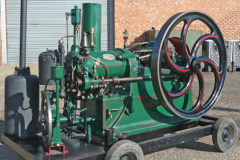1950 Leyland Hippo six-wheeler
Posted by Chris Graham on 30th November 2021
Bob Tuck meets Richard and Andrew Green and their fine 1950 Leyland Hippo six-wheeler with an interesting history.
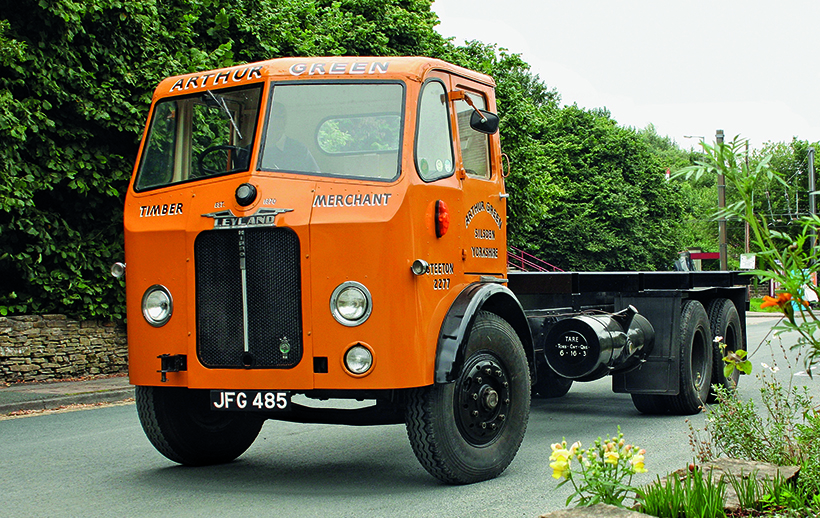
1950 Leyland Hippo six-wheeler: The vehicle looks magnificent today, following its stunning restoration.
This 1950 Leyland Hippo six-wheeler has seen all sorts of action in the 51 years it spent with timber specialist, Arthur Green of Silsden Ltd. It has appeared on BBC television and might well have been written off after a front tyre puncture caused an awful smash. And, while it later lay at rest in Green’s Old Station Yard for more than 30 years, this one-time mobile crane has certainly earned the right to be brought back to just-like-new condition. Thanks to the efforts of the two Green brothers – Richard and Andrew – plus many others (with a special mention for David Brent) this fine slice of Leyland heritage now certainly looks and sounds the part.
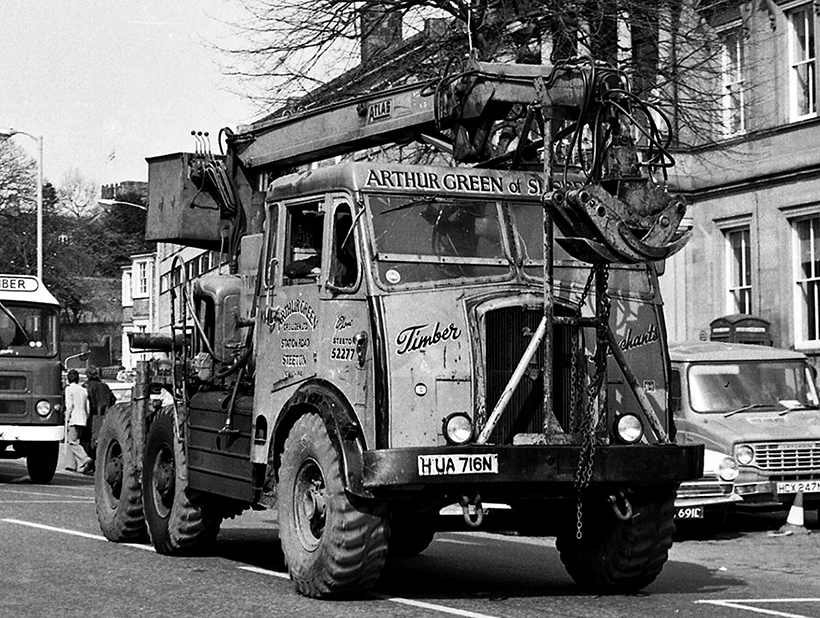
This Thornycroft HUA 716N was another mobile crane conversion carried out by Arthur Green, and was photographed by the late Colin Wright. If you want to hear a good story, just ask Andrew about the job they did with this crane in a solid bog, near Lincoln!
It’s the tick over of the Leyland 600 engine which does it for me every time. Richard Green had pulled his large frame up onto the driving seat of his Leyland Hippo and at first touch he fired its engine into life. “Don’t move off,” I begged him and then I asked if his feet were off the pedals as all I wanted to listen to was the soothing sound of that 9.8 litres on tick over as it waited to be called to work.
Engine sound nutters like me could stand around all day and wait for the diesel tank to empty before we tired of such a distinctive drawl. The Leyland 600 can have a habit of almost dying as part of its cycle but the slow reassuring sound just picks itself up – at the point you think it’s going to stall – and goes on and on. What a magical sound it can make although as we’ll discover, it doesn’t always sound like that.

When bought by Greens, the Hippo was converted for use into a mobile crane. Following a bad accident, the Leyland cab was replaced with this one, which came from an ex-Army Thornycroft. (Pic: Richard Green)
But that’s not the only surprise we’d encounter in the three hours we’d spend wallowing in the life and times of a business who can trace their origins back to 1870 as at their peak, they were one of the largest timber merchants in the country. And not forgetting Green’s were also one of the greatest Leyland devotees you could find simply because they felt the marque was as strong as they came.
Carting timber… and coal
With their distinctive yellow and black livery, the Arthur Green motors of old were a once seen, never forgotten sight. True, when carrying herculean sizes of felled round timber, it was their early loads that normally knocked your socks off because to many observers, the feat of just loading such masses in days of yesteryear was often beyond comprehension – never mind their subsequent road transport.

For some reason, the old Thornycroft cab was taken off the Leyland chassis before it was left in the corner of the Old Station yard.
(Pic: Richard Green)
Growing up in such a world was to be the two Green brothers – Richard and Andrew – and while there is five years’ difference in their birth years, these two septuagenarians share similar early thoughts of a ‘50s blend of felled timber mixed with Leyland load carriers: “I’m sure we bought our first two Leylands in 1934 and ’35,” says younger brother Andrew. “They were Badgers and ran with pole trailers.”

One from the Arthur Green archives sees their Leyland Hippo, RWW 24, in artic tractor unit form, with a load of beech in December 1958. (Pic: Richard Green)
The Arthur Green of Silsden business was established in 1870 but Richard explains it was his great grandfather Jeremiah who did the first timber haulage. The story goes that the local vicar asked his Church Warden (Jeremiah) if he could remove some trees and the business apparently started like that: “He also did a coal round,” says Andrew while Richards adds: “Subsequently his two sons Arthur and John took the business on but they were to later split and go their own ways.”
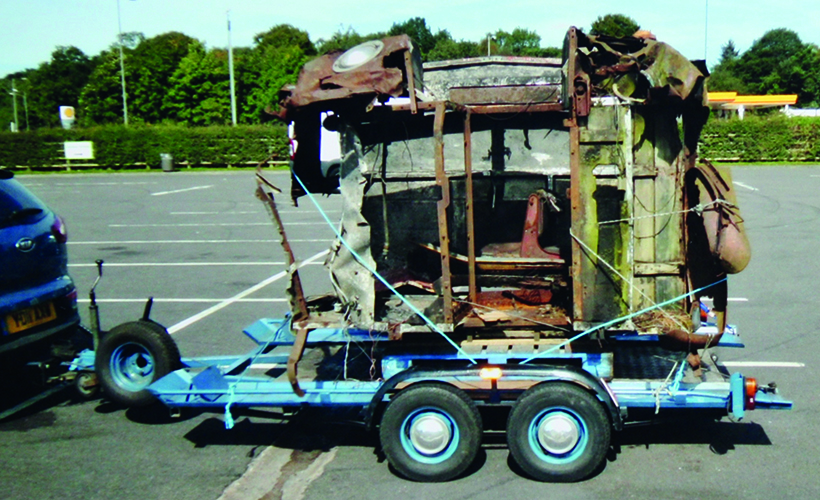
In search of a period Leyland cab, Richard contacted Mark Pyatt who furnished him with the remains of one he had. It took a steady drive back to Steeton to get these fragile remains back in one piece.
(Pic: Richard Green)
Although originally based at Silsden – which is less than five miles north of Keighley – the Arthur Green business worked country wide: “I’m sure at one time we employed 150 wood fallers alone,” says Andrew. As a timber merchant, Arthur Green would agree to buy certain standing timber and then fell it prior to hauling to a variety of end user customers. Before the mechanised load shifter, Arthur utilised teams of horses to drag the felled trees out of the woods and then cart it to the nearest railway station. And it was to be the steam powered train that covered most of the hauling distance: “We were still using this form of rail link up until the ‘60s,” recalls Andrew, “as I can recall one job at Elgin where we loaded the trains up there to bring all the timber south.”

Prior to the arrival of its cab, the Hippo chassis had been fully refurbished.
(Pic: Richard Green)
No surprise that Richard and Andrew both ended up working in the business their father Jerry took over after their grandfather – Arthur – died in 1959. Richard recalls going from school to being taught accountancy before a stint at the local Isles Leyland dealership at Stanningley near Leeds to discover how best to look after their favoured load shifter. Little did he realise that 60 years later he’d still be working on Leylands made in the ‘50s.
Andrew recalls it was in September ’64 that he left school and started out at Green’s as a Measurer. And for the next 20 years, visiting estates, woods and all manner of customers up and down the country would fill his working day. No surprise he’s still able to tell at a glance the names / sizes and even values of all manner of trees he might see.

That same cab is seen in the Steeton yard after David Brent had worked his magic on it. (Pic: Richard Green)
Prior to joining the Green payroll, both the brothers would spend as much as their non-school time as possible riding with the wood shifters. Richard recalls it was driver Walter Ibbotson who he liked going with best while Andrew says he normally accompanied Harold Turner when he was off.
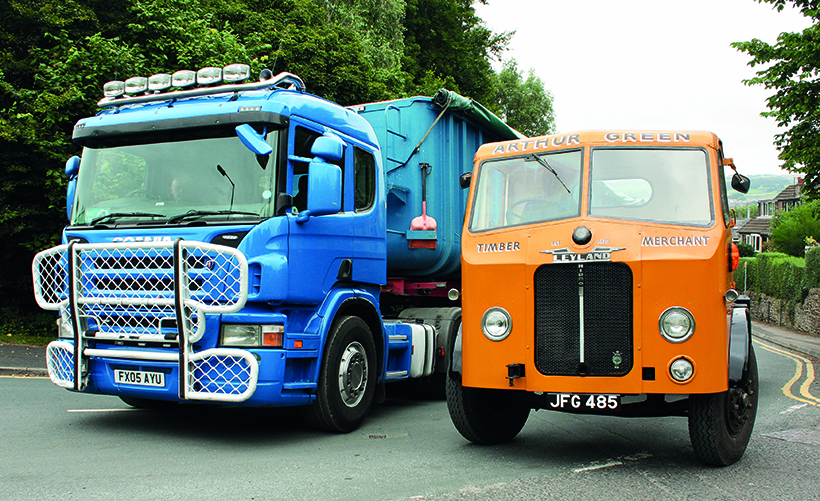
There’s about 55 years’ difference in the ages of these two vehicles. It makes you wonder how the ’05 Scania will compare to an equivalent load-shifter in, say, 2076?
Both the brothers agree that the performance of the Leyland wood carrier was phenomenal especially when you realise how demanding the conditions the Green wagons worked in. Underfoot the ground could be so bad that an empty artic had to be dragged into the forest to its loading point and then dragged back to the harder standing so it could then undertake its journey. And don’t forget these were the days when phenomenal weights were put on their backs. “The heaviest I can remember,” says Andrew, “was the day one motor grossed 42 tons and that was in the time when our maximum vehicle weight was 24 tons. We weren’t the only firm to overload as it was a way of life in the timber trade. But the Leylands could take this sort of work in their stride. I remember we bought FYG 205 and 206 new in 1947 and we worked them hard like this until 1966. At the time, you couldn’t beat Leyland for sheer strength.”

The two Green brothers – Richard (on the right) with younger brother, Andrew.
All change
With a business that has seen 151 years (and counting – as Richard is still working at the old Green HQ) then all manner of changes have been witnessed. But it’s probably the 1970s and ‘80s which saw the biggest upheaval in the Arthur Green activity. Actually the ‘60s had seen some transition as the timber world started to move away from transporting full length trees (on pole artics) to smaller cut down lengths of logs that could then be loaded onto bolster equipped rigids and artics.
To load these shorter lengths of timber, Green’s were to operate a small number of purpose made mobile cranes. These of course had to be capable of getting in and out of all sorts of difficult terrain and Andrew recalls an ex military 4×4 AEC Matador being an early one of these workhorses. It was the prospect of increasing their number of cranes that saw the arrival of JFG 485 in 1971: “It was just one of those things,” says Richard. “We already knew the old Leyland Hippo was as strong as they came and of course such a 6×4 would have made a great crane chassis. We just didn’t think there would be any old Hippos still knocking around.”
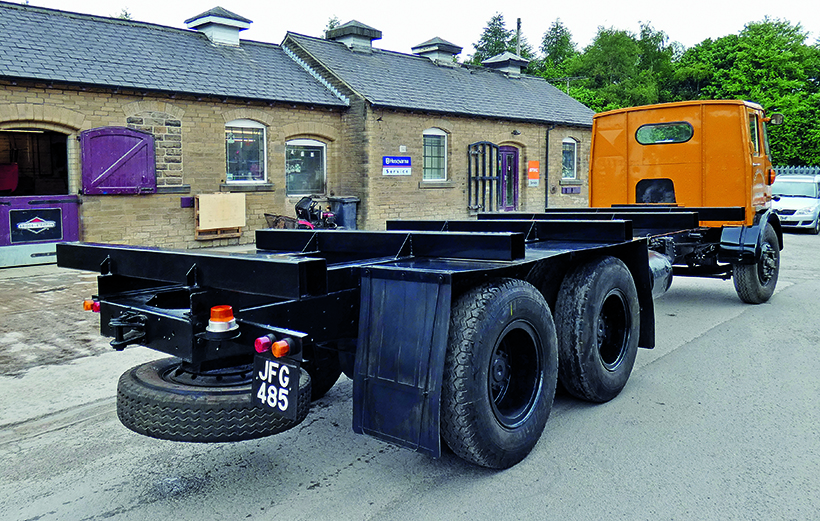
On 23rd May, 2018, Roy Dodsworth was on hand to record the day the Hippo’s restoration was completed. (Pic: Roy Dodsworth)
Andrew then realised he knew of such a motor at one of their customers in Northumberland: “I could remember seeing an old Hippo parked in Jeffrey’s yard north of Wooler. It just had a flat body on as they ran it carrying cut timber. It was at a time when six wheelers were still grossing 20 tons but the Jeffrey brothers could put 20 tons of payload on its back and it would still manage.”
The Hippo had actually started life in 1950 with Dunfermline based Robert Crawford Junior and 20 years later wasn’t worth a lot. But its pedigree was solid and after the deal was made, it was driven south by Arthur Newby who had been a driver mechanic at Arthur Green’s of Silsden for years. It was taken to what had recently become the new Green HQ – the Old Station Yard at nearby Steeton. Covering around two acres, the new premises would prove to be an ideal operating centre and is still the Green home more than 50 years later.
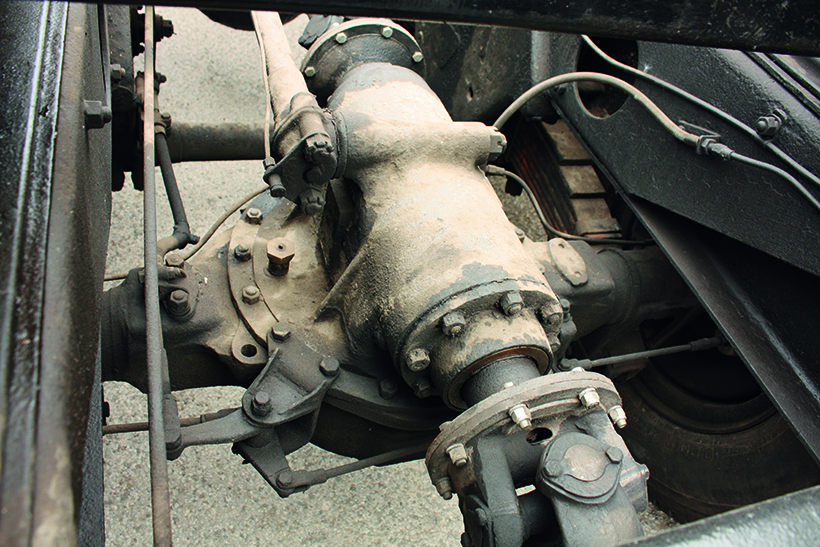
Now being fitted with an open bolster style of body allows you to easily examine the very sturdy Leyland driveline.
There was no great flap to do much with this six wheeler which was then painted a plain maroon colour but its nondescript appearance meant it proved ideal when the BBC came to call in late ‘71. “I don’t know how they heard about us,” says Richard, “but they were filming something called Blur & Blank via Cleckheaton and they wanted to hire the Hippo – and me as its driver.”
Richard was to also provide an old MG sports car he had but his two days at Howarth and then on Ilkley Moor was an experience he’d never forget: “I think it was one of a series of six plays and this one starred Denholm Elliott. Part of the filming involved him running down the road in front of me as a fog machine was blowing fog round me and I remember how he asked ‘Has it got brakes?’ about the old Leyland.”

Although this looks as though there’s something missing from the Hippo’s front suspension, the brothers point out that the vehicle was built like that so that an extra axle could be subsequently added to convert the Hippo into an eight-wheel Octopus.
Richard enjoyed this one off involvement but he was happier once the Hippo had been converted for crane work. The Arthur Green mechanics were to remove the flat body and even took off three foot from the rear of the chassis rails. They also converted the rear double drive bogie to carry Super Single 14.00×20 tyres before fitting the Atlas crane on the back.
The Hippo was to give the business about 10 years of active service although it might well have been written off the day a front tyre burst when it was heading towards the Lake District to load some trees: “Anthony Ibbotson was driving it near Clapham Common on the A65 and he ended up in a ditch after the tyre blew. He just had to leave it there overnight and returned with a new tyre and wheel and once that was changed, he carried on to do the job. The nearside of the cab was a bit of a mess but rather than write it off, we decided to fit another cab to it. We got one from Lockey’s scrap yard in Bingley that I’m sure came off an old Army Thornycroft. And once that was put on, it got all over the country – even as far south as Southampton. We kept using it until we finished with the timber work in the early ‘80s.” Yes, hard to believe but by the mid ‘80s, Arthur Green of Silsden Ltd had been obliged to take up an entirely different line of business.

The 1950 Hippo was fitted with a hydraulic braking system that was assisted by this vacuum servo.
More than 30 years at rest
The shift out of wood was prompted after the industry changed how it operated. This move saw merchants like Arthur Green by-passed as the end users dealt direct with the timber owners. Richard recalls seeing the transition coming so had first got into general haulage providing traction for Seaborne Shipping at Barking. This in turn was to lead to Continental haulage and at one point, Arthur Green had ten such outfits at work (with new Scanias being favoured to replace the Leyland fleet of old) but as Richard recalls, that work finished in ’99. “It was the year that the Prime Minister Tony Blair announced that if any illegal immigrant was discovered on a UK vehicle coming back from the Continent then the driver and the vehicle owner would be fined £2,000 each – for each illegal. I knew then we could never stand such a penalty for something we had no control of so we left haulage work altogether.”

Leyland dials of this period were in this distinctive square style.
The Old Station Yard proved an ideal place to use for rental to other people and the spare time on their hands allowed the Green brothers to enter the preservation world. And by the turn of the Millennium, the stunning Leyland Beaver with distinctive pole trailer EHH 130 was out and about flying the Arthur Green of Silsden flag once again. The restoration behind this specific vehicle was covered in ‘03 by our sister publication – Classic & Vintage Commercials – but as time passed, the brothers weren’t able to forget about their trusty Hippo. “It must have stood for over 30 years,” says Andrew. “It was just parked in the yard for about 10 years and I remember in ’90 we decided to move it out of the way. It started first pull on the rope and I drove it down to the bottom and it didn’t move then for another 22 years.”

Access to the Leyland cab is fairly easy.
Andrew thinks it may have been his subsequent suggestion in 2012 that perhaps the Hippo could be restored that started what would be an eventful six years. In fairness – once it was dragged out from the undergrowth – it did fire up once a battery and some fuel were offered so that was a positive sign but in truth, it proved a heck of a huge project for all the many people involved.
It’s not surprising that when you pool the knowledge of Richard and Andrew then you have all manner of memories of the Arthur Green operation. However, some details are still a bit of a mystery as neither brother can explain why they hung onto the old Hippo for so long (rather than scrap it when it came out of service) nor can they say why they took the old Thornycroft cab off before it was stood in the corner and allowed to vegetate.

There’s not much space between the fixed driving seat and the fixed steering wheel.
In search of a ‘50s style of mesh-front Leyland cab, Richard recalls contacting Leyland devotee Mark Pyatt who came up trumps with something. However, that 62-year-old something was to be the most fragile load Richard ever had to transport back up the motorway. Given the job to transform these delicate pieces of old Leyland metal into a brand new cab was to be David Brent. David had worked on the earlier Green Leyland Beaver restoration and was well known for his expertise but seeing what he did with these rusty remains still astounds both the Green brothers. Nice one David.
A lot of folk were involved in the six-year restoration with mechanics in the Green garage like Stuart Lambert doing work as and when time allowed. The talents of Paul Hickman were utilised to re-wire the Hippo and as Green’s have long dealt with Leylands of old, there was nothing new in slowly working from tip to toe on this labour of love.
It was still a big day when the ‘new’ Brent / Leyland cab was placed back onto the freshly restored Hippo chassis and the job was getting close to completion – until the brothers realised they had dropped a clanger. “When the Hippo had the ex-Army cab put on in the ‘70s,” says Richard, “we also fitted the steering box and column in place of the Leyland one. But once we put the new cab on, the setup meant the steering wheel was far too high so we had to replace the column again. We only wished we’d done all that work before we’d put the new cab in place.”

Glazing in the centre of the back of the cab allows for ideal, all-round vision.
Back on the road
First outing for the fully restored Hippo was on the 10th June ’18 when it went to Newby Hall. The Leyland had actually been finished about a month earlier and Roy Dodsworth was on hand to photograph that memorable occasion. Being born at Ilkley, Roy has long been a close friend of the Green family and recalls how when his dad made a wooden greenhouse, Arthur Green arranged to have the wood cut to size when Green’s had a sawmill at nearby Addingham. “I got to know Richard Green in particular very well,” says Roy. “I’ve been involved with the Trans-Pennine Run since the late ‘70s and Richard was always very supportive of that particular event.” Roy planned to write us a comprehensive feature of the Hippo restoration but sadly he was unable to do that because of poor health and yours truly was asked to take on the job.
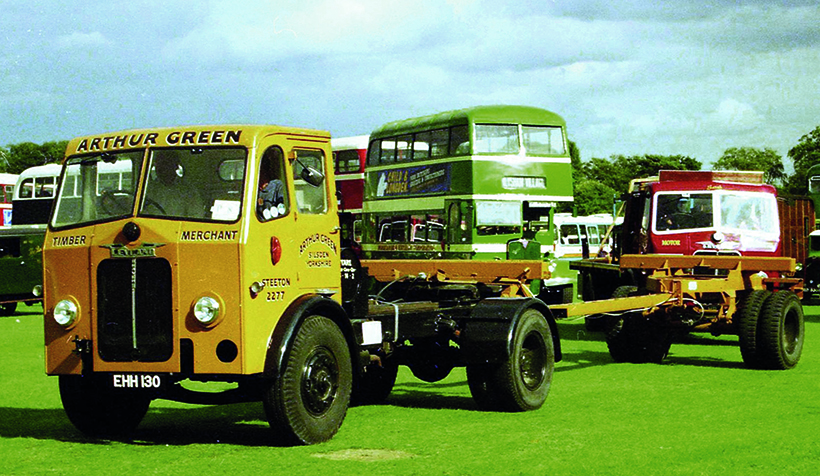
This Leyland Beaver and pole trailer was the first Green restoration. Phil Moth photographed it at the end of the Trans-Pennine Run at Harrogate. (Pic: PM Photography)
This of course was no hardship for me especially when I’m rewarded by being given a personal playing of the Leyland Concerto No. 600. I was also allowed to take the Hippo for a shuffle round the Green yard although my test drive wasn’t that impressive. It’s an easy enough cab to get into and Richard says that 3rd gear is enough to get into motion. I try a shift up to 4th but fail miserably and realise that handling this Hippo ‘box is an art indeed. Andrew agrees that of the two he prefers to drive the Beaver although when they take both their Leylands out, the brothers say they swop over with the vehicles on any round trip.
Keeping the Arthur Green of Silsden flag flying is no hardship to these two septuagenarian brothers, especially when they have to ride and drive examples of the finest servant their company could have wished for. Happy days are certainly back again for Richard and Andrew.
For a money-saving subscription to Heritage Commercials magazine, simply click here



